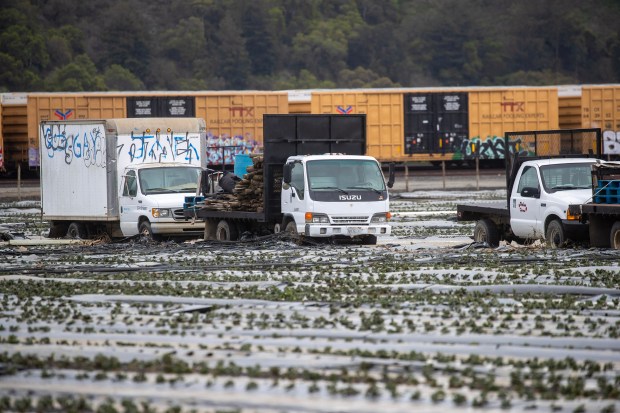Like so many in the fertile Pajaro Valley where livelihoods are linked to the rhythms of the growing season, Fabiola Alcaraz is anxiously eyeing the calendar as fields and equipment that deliver a bounty of beautiful red strawberries and raspberries sit under several feet of muddy floodwater.
She manages a cold storage unit in Pajaro that keeps the freshly picked berries cool as they await shipment to grocers throughout the Bay Area and beyond. But a breach longer than a football field that severed a levee upstream during Saturday rainstorms spilled floodwater through the town and into the nearby farms.

Within weeks, strawberries will be coming in from other farms along the coast that were spared the brunt of the storm’s wrath.
“We need to get back as soon as possible,” Alcaraz said. “We grow strawberries half a mile north and south of Pajaro, and need to be ready for the strawberry season.”
Berries and lettuce are the sixth and eighth most valuable crops in California, the top-valued U.S. producer of agriculture, according to the California Department of Food and Agriculture.
And agriculture is a $4.1 billion industry in Monterey County, the fourth most valuable producer in the state, known mostly for its lettuce, strawberries, broccoli and grapes.
Much of that harvest is produced in the Salinas River valley, but a significant portion comes from the Pajaro Valley, divided between Santa Cruz County along the north bank and Monterey County along the south.
The flood has come at a crucial time for the valley’s growers. Strawberries and raspberries, planted in the fall, typically produce their first crops in March and April. Lettuce and broccoli grow on 60- to 80-day crop cycles, said Monterey County Agricultural Commissioner Juan Hidalgo.
For the berry crops, the season has been delayed by the rainy weather, and the plants haven’t yet begun to flower and produce fruit, Hidalgo said. That’s potentially good news — if the floodwaters recede soon, plants that weren’t washed away might recover and produce fruit.
“Plants can be quite hardy and they can recover,” Hidalgo said. “We don’t expect those plants to begin to flower or produce fruit until maybe middle of April. But if they stay underwater for too many days, it’s definitely going to have some very severe impacts to those growers.”
But that “assumes there is something still in the ground,” to recover, Hidalgo said. Until the floodwaters recede, Hidalgo said, it’s impossible to say whether the plants remained rooted in the soil or were swept away for what he said would be a total season loss.
For leafy vegetables like lettuce, any crops now sitting under flood water would be gone. And the next cycle is also in doubt, because many growers plant new crops around this time of year.
But it will be tough to move quickly. Norm Groot, executive director of the Monterey County Farm Bureau, said that under stricter food safety protocols established after contaminated crops caused illnesses in 2008, the soils and irrigation systems will have to be inspected and tested for pathogens after the floodwaters recede, and before crops can be planted.
“This could be a 60-day process after waters recede from the fields and damage assessments can be fully made — food safety is our highest priority, and growers will follow the protocols,” Groot said. “With fields being so saturated and inaccessible, planting schedules that are set for March will probably be delayed. Determining when planting schedules can begin will depend on how quickly the fields that are not impacted by flooding or inundation can be accessed and worked for planting.”
Hidalgo said Pajaro growers could lose 30%-50% of their crop yield, but couldn’t say Tuesday what the value of the losses would be or whether they would affect consumer prices.
Repair crews have been working around the clock to plug the gap in the levee, and have reported significant progress, narrowing to 20 feet wide a hole that stretched 365 feet earlier Monday.

But rain from yet another atmospheric river storm continued to pour more water into the Pajaro’s 1,300 square mile watershed Tuesday, and while clearing was forecast into the weekend, another round of rain is expected early next week.
“Waters may not recede until that levee break can be reconstructed,” Groot said. “This poses a serious threat to crop production for the entire spring season and possibly longer.”
It’s also a hit to the people who toil in the fields to plant and harvest the crops. Groot said most farmworkers aren’t employed directly by the growers but in contract labor situations, and can work in the area and other fields that weren’t inundated by water. But Blanca Zarazua, a lawyer who works with the Mexican consulate to help Spanish-speaking clients, said many farmworkers’ homes were flooded. They can’t easily relocate, are out of work and worried.
Many in Pajaro’s agricultural community feel the flood risks they face haven’t been given the priority they deserve.
“They’ve just neglected to allocate resources to this problem,” said Jake Brooks, co-owner of Ladybug Farms, which grows flowers and cannabis in Pajaro. His farm operation wasn’t flooded, but limited road access forced them to divert their workers to another site in San Mateo County.
Shaunna Murray, senior water resources engineer at the Monterey County Water Resources Agency, said the agency has “done the maintenance based on the funding (it has) received.”
But Alcaraz just hopes they fix the levee for good so farm-related businesses don’t suffer more losses.
“I don’t want it to happen where we just reconstruct and three years later have to do it all over again,” Alcaraz said. “That would be horrible.”
Source: www.mercurynews.com
